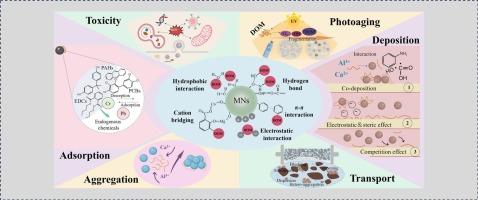超越表面:溶解的有机物质如何重塑水生环境中微和纳米塑料的生物地球化学行为
IF 7.2
1区 地球科学
Q1 GEOSCIENCES, MULTIDISCIPLINARY
引用次数: 0
摘要
微纳米塑料(MNs)和溶解性有机物(DOM)在水生环境中广泛共存,它们之间的相互作用越来越受到人们的关注。这些相互作用影响了自然系统中塑料颗粒的生物地球化学行为。然而,DOM参与下MNs的行为特征、命运过程和生态毒理学影响尚未得到系统分析。因此,本文综述了DOM对MNs光老化的促进和抑制机制,其中DOM的原发色团(吸光实体)可以诱导三激发态DOM (3DOM*)和活性氧(ROS)的产生,从而促进MNs光老化,或者通过屏蔽光线和清除反应中间体来限制MNs光老化。DOM对纳米粒子稳定性的影响被强调,其中氢键、库仑力、疏水力和π-π键等力可以帮助调解DOM和纳米粒子之间的相互作用,由此产生的额外静电和空间效应随后主导了粒子的聚集、沉积和传输行为。讨论了DOM对MNs吸附水中无机和有机污染物的影响及其干扰机理。此外,特别关注DOM与MNs形成的生态和生物电晕对水生生物群的毒理学影响,它提供了一层保护涂层,降低了颗粒的物理化学毒性,但在某些情况下,它可能会加剧毒性。最后,提出了DOM-MNs相互作用及其相关效应需要解决的知识缺口,以及未来的研究方向。本文章由计算机程序翻译,如有差异,请以英文原文为准。

Beyond the surface: how dissolved organic matter recasts the biogeochemical behaviors of micro- and nanoplastics in aquatic environments
Micro- and nanoplastics (MNs) and dissolved organic matter (DOM) widely coexist in aquatic environments, and their interactions are receiving increasing attention. These interactions influence the biogeochemical behaviors of plastic particles in natural systems. However, the behavioral characteristics, fate processes, and ecotoxicological impacts of MNs under DOM involvement have not been systematically analyzed. Therefore, this review summarizes the promotion and inhibition mechanisms of DOM on MNs photoaging, in which the primary chromophore (light-absorbing entity) of DOM can induce the production of triply excited state DOM (3DOM*) and reactive oxygen species (ROS) to promote MNs photoaging, or alternatively, limit MNs photoaging by shielding light and scavenging the reactive intermediates. The effect of DOM on the stability of MNs particles is emphasized, where forces such as hydrogen bonding, coulombic forces, hydrophobic forces, and π-π bonding can help mediate the interaction between DOM and MNs, with the resulting additional electrostatic and spatial effects subsequently dominating the aggregation, deposition, and transport behaviors of the particles. The impacts of DOM on the adsorption of inorganic and organic pollutants in water by MNs and their corresponding interference mechanisms are discussed. Additionally, special attention focuses on the toxicological effects on aquatic biota of the ecological and biological corona formed by DOM with MNs, which provides a protective coating that reduces the physicochemical toxicity of particles, but in certain cases, it may exacerbate toxicity. Finally, knowledge gaps that need to be addressed for DOM-MNs interactions and related effects, as well as future research directions are presented.
求助全文
通过发布文献求助,成功后即可免费获取论文全文。
去求助
来源期刊

Gondwana Research
地学-地球科学综合
CiteScore
12.90
自引率
6.60%
发文量
298
审稿时长
65 days
期刊介绍:
Gondwana Research (GR) is an International Journal aimed to promote high quality research publications on all topics related to solid Earth, particularly with reference to the origin and evolution of continents, continental assemblies and their resources. GR is an "all earth science" journal with no restrictions on geological time, terrane or theme and covers a wide spectrum of topics in geosciences such as geology, geomorphology, palaeontology, structure, petrology, geochemistry, stable isotopes, geochronology, economic geology, exploration geology, engineering geology, geophysics, and environmental geology among other themes, and provides an appropriate forum to integrate studies from different disciplines and different terrains. In addition to regular articles and thematic issues, the journal invites high profile state-of-the-art reviews on thrust area topics for its column, ''GR FOCUS''. Focus articles include short biographies and photographs of the authors. Short articles (within ten printed pages) for rapid publication reporting important discoveries or innovative models of global interest will be considered under the category ''GR LETTERS''.
 求助内容:
求助内容: 应助结果提醒方式:
应助结果提醒方式:


